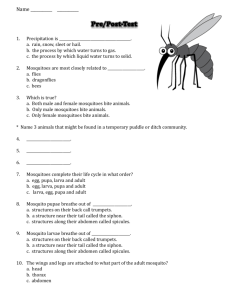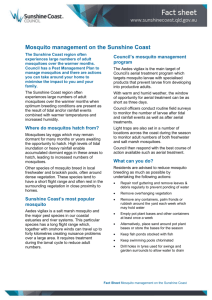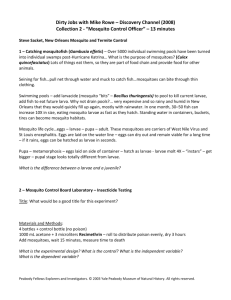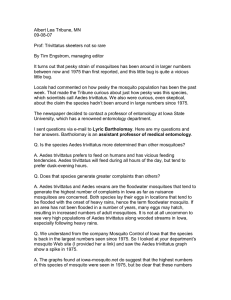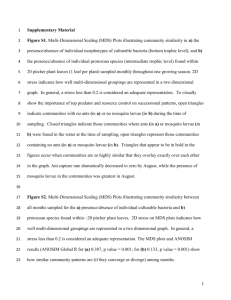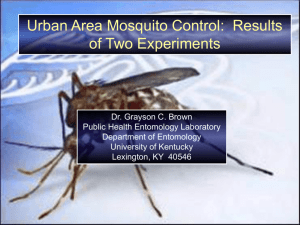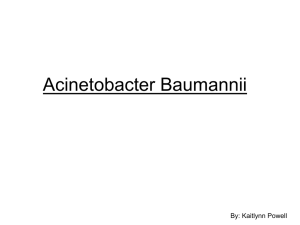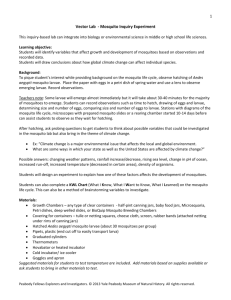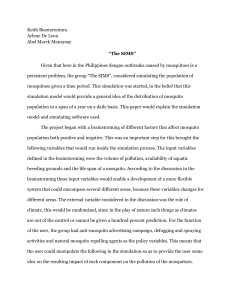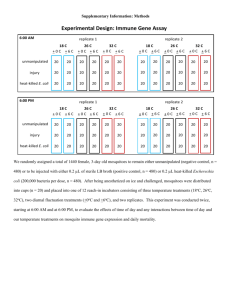Epizone
advertisement
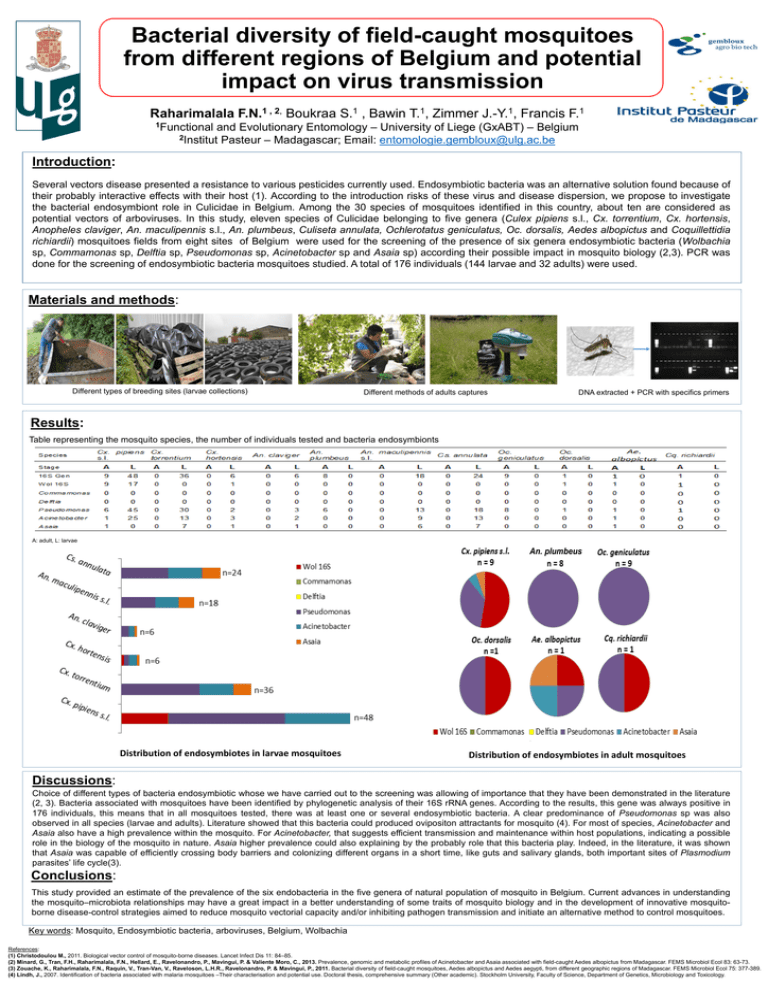
Bacterial diversity of field-caught mosquitoes from different regions of Belgium and potential impact on virus transmission Raharimalala F.N.1 , 2, Boukraa S.1 , Bawin T.1, Zimmer J.-Y.1, Francis F.1 and Evolutionary Entomology – University of Liege (GxABT) – Belgium 2Institut Pasteur – Madagascar; Email: entomologie.gembloux@ulg.ac.be 1Functional Introduction: Several vectors disease presented a resistance to various pesticides currently used. Endosymbiotic bacteria was an alternative solution found because of their probably interactive effects with their host (1). According to the introduction risks of these virus and disease dispersion, we propose to investigate the bacterial endosymbiont role in Culicidae in Belgium. Among the 30 species of mosquitoes identified in this country, about ten are considered as potential vectors of arboviruses. In this study, eleven species of Culicidae belonging to five genera (Culex pipiens s.l., Cx. torrentium, Cx. hortensis, Anopheles claviger, An. maculipennis s.l., An. plumbeus, Culiseta annulata, Ochlerotatus geniculatus, Oc. dorsalis, Aedes albopictus and Coquillettidia richiardii) mosquitoes fields from eight sites of Belgium were used for the screening of the presence of six genera endosymbiotic bacteria (Wolbachia sp, Commamonas sp, Delftia sp, Pseudomonas sp, Acinetobacter sp and Asaia sp) according their possible impact in mosquito biology (2,3). PCR was done for the screening of endosymbiotic bacteria mosquitoes studied. A total of 176 individuals (144 larvae and 32 adults) were used. Materials and methods: Different types of breeding sites (larvae collections) Different methods of adults captures DNA extracted + PCR with specifics primers Results: Table representing the mosquito species, the number of individuals tested and bacteria endosymbionts A: adult, L: larvae An. plumbeus Distribution of endosymbiotes in larvae mosquitoes Distribution of endosymbiotes in adult mosquitoes Discussions: Choice of different types of bacteria endosymbiotic whose we have carried out to the screening was allowing of importance that they have been demonstrated in the literature (2, 3). Bacteria associated with mosquitoes have been identified by phylogenetic analysis of their 16S rRNA genes. According to the results, this gene was always positive in 176 individuals, this means that in all mosquitoes tested, there was at least one or several endosymbiotic bacteria. A clear predominance of Pseudomonas sp was also observed in all species (larvae and adults). Literature showed that this bacteria could produced ovipositon attractants for mosquito (4). For most of species, Acinetobacter and Asaia also have a high prevalence within the mosquito. For Acinetobacter, that suggests efficient transmission and maintenance within host populations, indicating a possible role in the biology of the mosquito in nature. Asaia higher prevalence could also explaining by the probably role that this bacteria play. Indeed, in the literature, it was shown that Asaia was capable of efficiently crossing body barriers and colonizing different organs in a short time, like guts and salivary glands, both important sites of Plasmodium parasites’ life cycle(3). Conclusions: This study provided an estimate of the prevalence of the six endobacteria in the five genera of natural population of mosquito in Belgium. Current advances in understanding the mosquito–microbiota relationships may have a great impact in a better understanding of some traits of mosquito biology and in the development of innovative mosquitoborne disease-control strategies aimed to reduce mosquito vectorial capacity and/or inhibiting pathogen transmission and initiate an alternative method to control mosquitoes. Key words: Mosquito, Endosymbiotic bacteria, arboviruses, Belgium, Wolbachia References: (1) Christodoulou M., 2011. Biological vector control of mosquito-borne diseases. Lancet Infect Dis 11: 84–85. (2) Minard, G., Tran, F.H., Raharimalala, F.N., Hellard, E., Ravelonandro, P., Mavingui, P. & Valiente Moro, C., 2013. Prevalence, genomic and metabolic profiles of Acinetobacter and Asaia associated with field-caught Aedes albopictus from Madagascar. FEMS Microbiol Ecol 83: 63-73. (3) Zouache, K., Raharimalala, F.N., Raquin, V., Tran-Van, V., Raveloson, L.H.R., Ravelonandro, P. & Mavingui, P., 2011. Bacterial diversity of field-caught mosquitoes, Aedes albopictus and Aedes aegypti, from different geographic regions of Madagascar. FEMS Microbiol Ecol 75: 377-389. (4) Lindh, J., 2007. Identification of bacteria associated with malaria mosquitoes –Their characterisation and potential use. Doctoral thesis, comprehensive summary (Other academic). Stockholm University, Faculty of Science, Department of Genetics, Microbiology and Toxicology.

